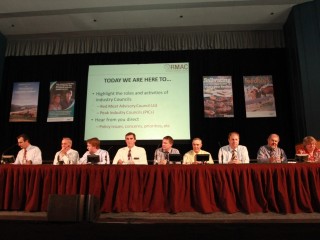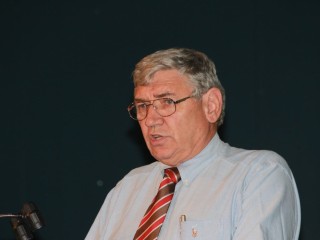 Red meat structural issues took centre stage at Longreach last week where livestock producers and leaders gathered for Meat and Livestock Australia’s annual general meeting.
Red meat structural issues took centre stage at Longreach last week where livestock producers and leaders gathered for Meat and Livestock Australia’s annual general meeting.
Evidence of an emerging appetite for structural reform in recent months prompted the Red Meat Advisory Council (RMAC) to hold a forum before last Thursday’s AGM to provide industry stakeholders with an oportunity to discuss existing structures and preferred alternatives.
A 90 minute forum commenced with an explanation of the structure, funding mechanism and role of each peak council under that the Red Meat Advisory Council’s umbrella: the Cattle Council of Australia, the Australian Lot Feeders Association, the Australian Livestock Exporters Council, the Sheepmeat Council of Australia and the Goat Industry Council of Australia. The Australian Meat Industry Council representing the processing sector was not represented at the forum.
The meeting heard that the primary roles of the Red Meat Advisory Council were to advise the minister for agriculture on red meat issues and to speak with one voice on behalf of the red meat sector’s peak councils, when it was able to achieve a consensus position between each body on specific issues.
 RMAC chairman Ross Keane said the existing structure provided a vehicle for each peak council to advise each other, to share ideas and potential solutions to problems. “We don’t get consensus on every issue naturally, but we do listen to each other constructively and go through a process of debating each other’s challenges,” Mr Keane said.
RMAC chairman Ross Keane said the existing structure provided a vehicle for each peak council to advise each other, to share ideas and potential solutions to problems. “We don’t get consensus on every issue naturally, but we do listen to each other constructively and go through a process of debating each other’s challenges,” Mr Keane said.
Cattle Council of Australia chief executive officer David Inall said that one of the most common criticisms levelled at the red meat industry by parliamentarians was that, unlike the mining industry, it rarely spoke with one voice, and instead came to Canberra in various groups.
“RMAC is endeavouring wherever possible to provide a uniform message, and now with a full-time chairman, when we have that cross-pollination in one position it is the RMAC chairman’s role to speak on all of our behalf,” Mr Inall said. “Instead of six groups going in, we just have one.”
One example of the difficulty that can be raised in achieving consensus between the red meat sectors different groups was highlighted in a question from Northern Territory Cattlemen’s Association president Rohan Sullivan. The NT cattleman asked whether RMAC provided any advice to the federal agriculture minister during the live export crisis, given the public stance taken in favour of the ban on live exports by processors, which contrasted with the position taken by two other members – the Cattle Council of Australia and the Australian Live Exporters Council.
“We didn’t have a consensus view on it, so we didn’t advise the minister,” Mr Keane said. “When we don’t have a consensus, we don’t advise the minister.”
Mood for change
A number of speakers discussed the reason why they believe a change in structure is needed.
CQ cattleman Cameron McIntyre said a majority of MLA levy payers were not members of State Farming Organisations, and therefore were not directly represented by Cattle Council of Australia. He suggested that unrepresented levy payers should be included on any task force established to oversee the restructure of representative bodies.
Funding of policy bodies was also an issue: “We have a body (Cattle Council of Australia) with a budget of just over $1 million that is meant to be our lobby body that is meant to be advising the minister. They are meant to be doing all these things on a budget of $1m, and they are meant to be controlling a body (MLA) that has a budget of $170m.
Fellow CQ cattle producer Joanne Rea said such funding discrepancies highlighted the dysfunction of existing structures. “I’m alarmed at the disjoint in the funding, and that people who have our dollars (MLA) are the ones who are apparently not responsible for things like live export, and the people (CCA, SMCA, ALEC) who nominally are responsible for things like live export and the people who nominally are responsible for running it and managing it and fixing it when it goes wrong have got no money.”
Cattle Council of Australia chairman Andrew Ogilvie said the organisation had always embraced change, which was why its representatives were in the forum to listen to ideas. “We’re in the process of a structural review and recent events have led us to believe there are some good ideas out there that we can use to make a better decision to structure our change, and that is why we’re here to listen to you today.”
Suggestions for change
Acton Super Beef’s Graeme Acton told the forum there were three fundamental issues to consider: providing a mechanism that allowed all transaction levy payers in Australia to directly elect councillors onto the board of Cattle Council of Australia; to use a component of the transaction levy to fund peak councils; and to clearly define the roles of peak councils and the service delivery organisation MLA.
Crookwell, NSW cattle producer John Carter asked RMAC chairman Ross Keane to initiate a full and impartial analysis of every levy-funded organisation in the red meat sector to determine needs and where money should be going. “Because if we just increase the money, we’ll increase the bureaucracy,” he said.
Mr Keane said the key purpose of the forum was to delineate the responsibilities of each group and to make existing arrangements clearer.
He added that an RMAC-initiated review could also be on the cards: “We do have in place a review, that hasn’t been enacted yet, but we are considering it,” Mr Keane said.
Graeme Acton said the industry needed a strong voice speaking on its behalf in Canberra: “We want our industry to be strong enough to tell the minister what to do,” he said. “The trouble with this organisation and this industry is that we don’t know ourselves who is the peak council who the minister should be talking to, and this what we have got to take on board.
“We have got to have an identity in this industry who is going to talk to the minister with everyone behind him or her and the minister is going to listen.”
Later during the MLA AGM Mr Acton asked MLA chair Don Heatley if he believed a component of the transaction levy should be used to fund industry representative groups.
“The levy is not ours to make a determination on. It is in the control of the peak councils,” Mr Heatley said. “We are truly the service provider to industry – and we don’t have a determination on it.”
While a strong mood for change was evident, two industry leaders cautioned against making change for change’s sake.
Sheepmeat Council of Australia executive director Ron Cullen said the last red meat industry restructure took two years to complete. He said the industry had to be clear about which issues a restructure could address and which issues were outside the influence of a restructure. ALFA president Jim Cudmore also urged the industry to be “very, very clear about what we’re trying to do”.
Georgina Pastoral Company’s Peter Hughes also councilled against restructures that involve Government funding. “Once you get Government money in, they start to get control and you’re dealing with people who really don’t understand.
“They can be very detrimental to the industry if they get that hold on you, and we’ve seen examples of that around and we don’t want that. We do have to find a better way of financing our bodies, stay away from the Government.”
Boom or bust?
John McDonald from Bindaree Beef said the livestock industry was going backwards and that the viability of many enterprises was struggling.
Young cattle were worth $50 a head less than they were six years ago, but in that time MLA had spent approximately $1 billion of levies on marketing and R&D, inflation had increased by 20pc, domestic beef consumption had decreased and chicken consumption had increased.
However, some challenged that notion that falling domestic consumption was an issue of concern.
Like the beef industry the sheepmeat sector was also experiencing falling domestic consumption. But this was not deemed to be a serious concern, Sheepmeat Council of Australia executive director Ron Cullen said, because it reflected the fact that a greater percentage of production was being exported to higher value overseas markets.
“We’re actually actively working towards that outcome, (because) for our sheepmeat producers it means that overseas countries are paying more for product than the Australian market is prepared to pay.
“We think increased profitability for our producers is of more importance than current consumption trends in the domestic market place.”
He urged people to understand that there were many forces outside the influence of peak councils and service delivery organisations.
“Since I have been CEO of the sheepmeat council, the price for sheepmeat and lamb has risen dramatically,” Mr Cullen said.
“So if you would like to credit me with that success I would be happy to take it. However, I think it is derived from circumstances outside my control, and circumstances outside the control of my council.”
WA beef producer Lang Coppin also questioned the view that the industry is immersed in doom and gloom. He said he was getting the best price ever for his export cattle to Israel, and the rural media was full of stories of record prices for livestock.
“Buggered if I know, but I reckon you should be able to pay your bills with the sort of money we’re getting at the moment.”



HAVE YOUR SAY